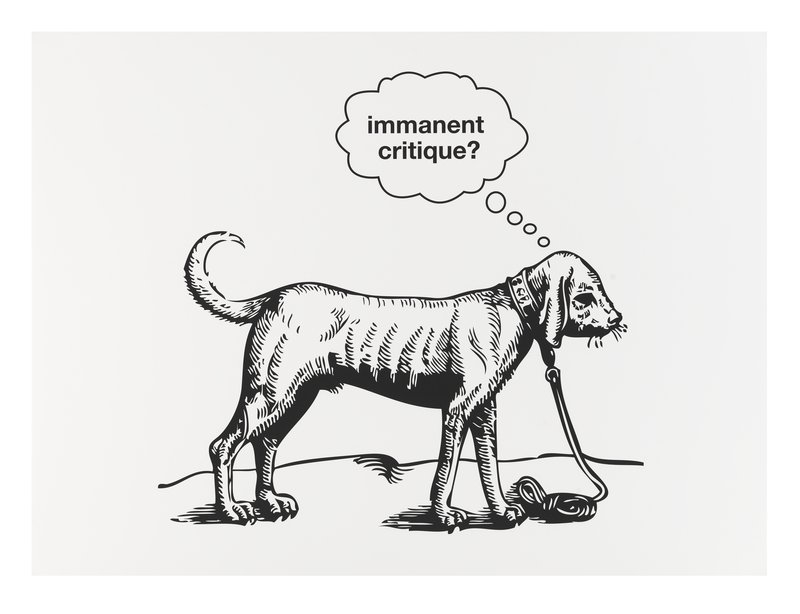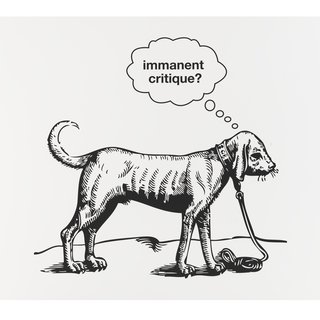About The Work
Liam Gillick’s Immanent Critique takes a phrase familiar to anyone who has struggled through the dense philosophical writings of 18th Century German think Immanuel Kant, and reduces it to a momentary thought in the life of a dog. The attribution of human thoughts and behaviors (walking and talking) to animals has been central to animated entertainment and puppetry for decades, yet while these images—static or moving—have largely either been directed towards children, or towards more irreverently “adult” thematics (from R. Crumb’s Fritz the Cat, to The Family Guy’s dog-character Brian Griffin), Gillick’s invocation of this trope is far more sophisticated and deadpan. It softly lampoons the tendency of pet-owners (and dog-owners especially) to bestow emotions and informed responses onto the beloved animals in their care, yet inserts a complicated philosophical notion that would be equally improbable of popping into the average human’s brain, much less that of a canine.
Courtesy of Art+Culture Projects
About Liam Gillick
From The Magazine
- Interviews & Features: Can Abstract Painting Be Political? Curator Alex Gartenfeld on the Secret Power Relations Embedded in Contemporary Canvases
- Art 101: What Is Relational Aesthetics? Here's How Hanging Out, Eating Dinner, and Feeling Awkward Became Art
- Contributors: Curator and Publisher Dorothée Dupuis's Picks from Material Art Fair 2016
- Art 101: Hans Ulrich Obrist on the Historic Import of AnnLee, Pierre Huyghe and Philipe Parreno's Self-Aware Manga Creation
- Interviews & Features: Sarah Morris on Uncovering Conspiracies in the Art-Luxury Industrial Complex
Pigment print on Somerset velvet paper 300gsm
30.00 x 40.00 in
76.2 x 101.6 cm
This work is signed and numbered by the artist.
About The Work
Liam Gillick’s Immanent Critique takes a phrase familiar to anyone who has struggled through the dense philosophical writings of 18th Century German think Immanuel Kant, and reduces it to a momentary thought in the life of a dog. The attribution of human thoughts and behaviors (walking and talking) to animals has been central to animated entertainment and puppetry for decades, yet while these images—static or moving—have largely either been directed towards children, or towards more irreverently “adult” thematics (from R. Crumb’s Fritz the Cat, to The Family Guy’s dog-character Brian Griffin), Gillick’s invocation of this trope is far more sophisticated and deadpan. It softly lampoons the tendency of pet-owners (and dog-owners especially) to bestow emotions and informed responses onto the beloved animals in their care, yet inserts a complicated philosophical notion that would be equally improbable of popping into the average human’s brain, much less that of a canine.
Courtesy of Art+Culture Projects
About Liam Gillick
From The Magazine
- Interviews & Features: Can Abstract Painting Be Political? Curator Alex Gartenfeld on the Secret Power Relations Embedded in Contemporary Canvases
- Art 101: What Is Relational Aesthetics? Here's How Hanging Out, Eating Dinner, and Feeling Awkward Became Art
- Contributors: Curator and Publisher Dorothée Dupuis's Picks from Material Art Fair 2016
- Art 101: Hans Ulrich Obrist on the Historic Import of AnnLee, Pierre Huyghe and Philipe Parreno's Self-Aware Manga Creation
- Interviews & Features: Sarah Morris on Uncovering Conspiracies in the Art-Luxury Industrial Complex
- Ships in 10 to 14 business days from New York. Framed works ship in 14 to 18 business days from New York.
- This work is final sale and not eligible for return.
- Questions about this work?
- Interested in other works by this artist or other artists? We will source them for you.
- Want to pay in installments?
Contact an Artspace Advisor
advisor@artspace.com

























